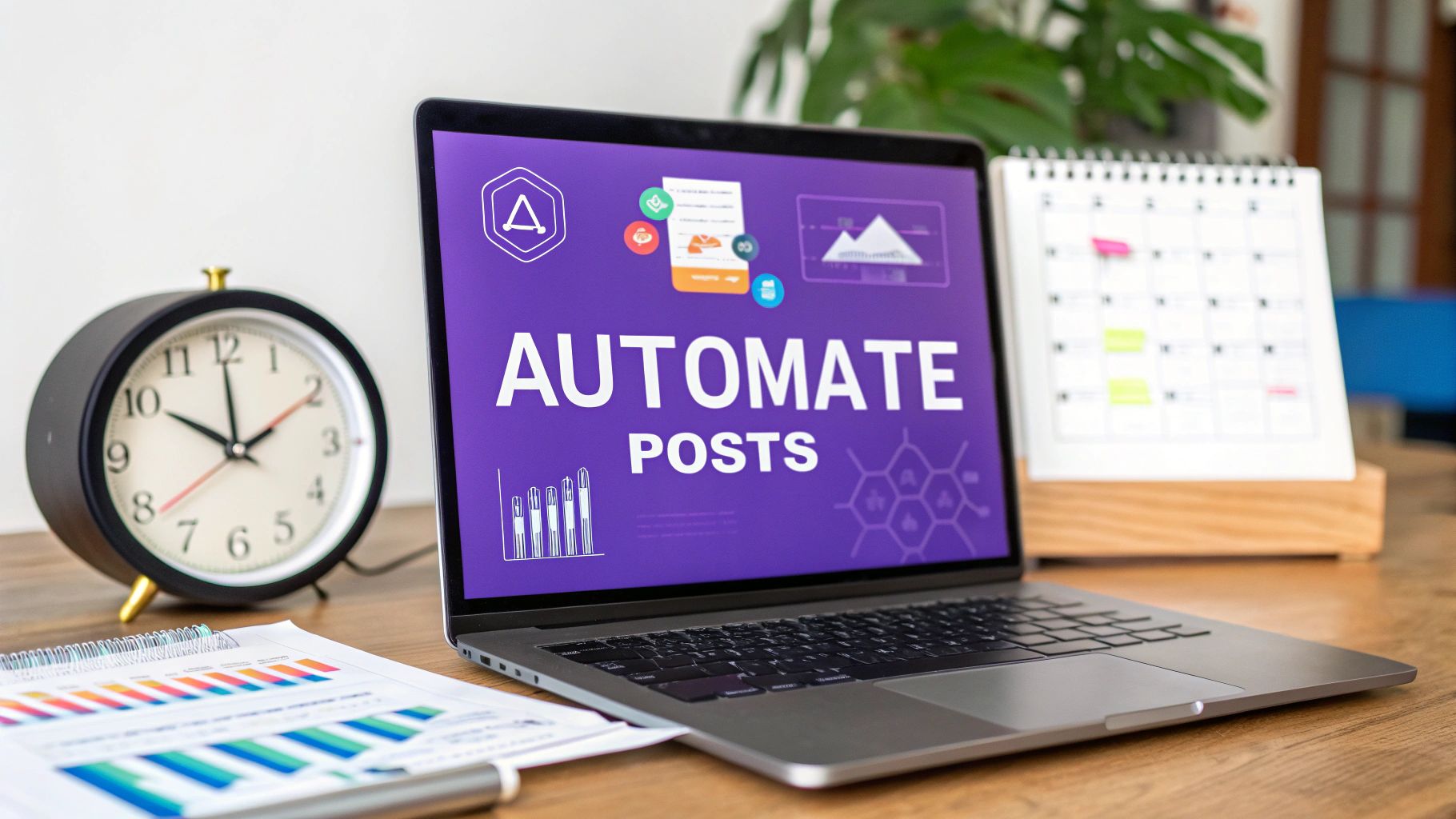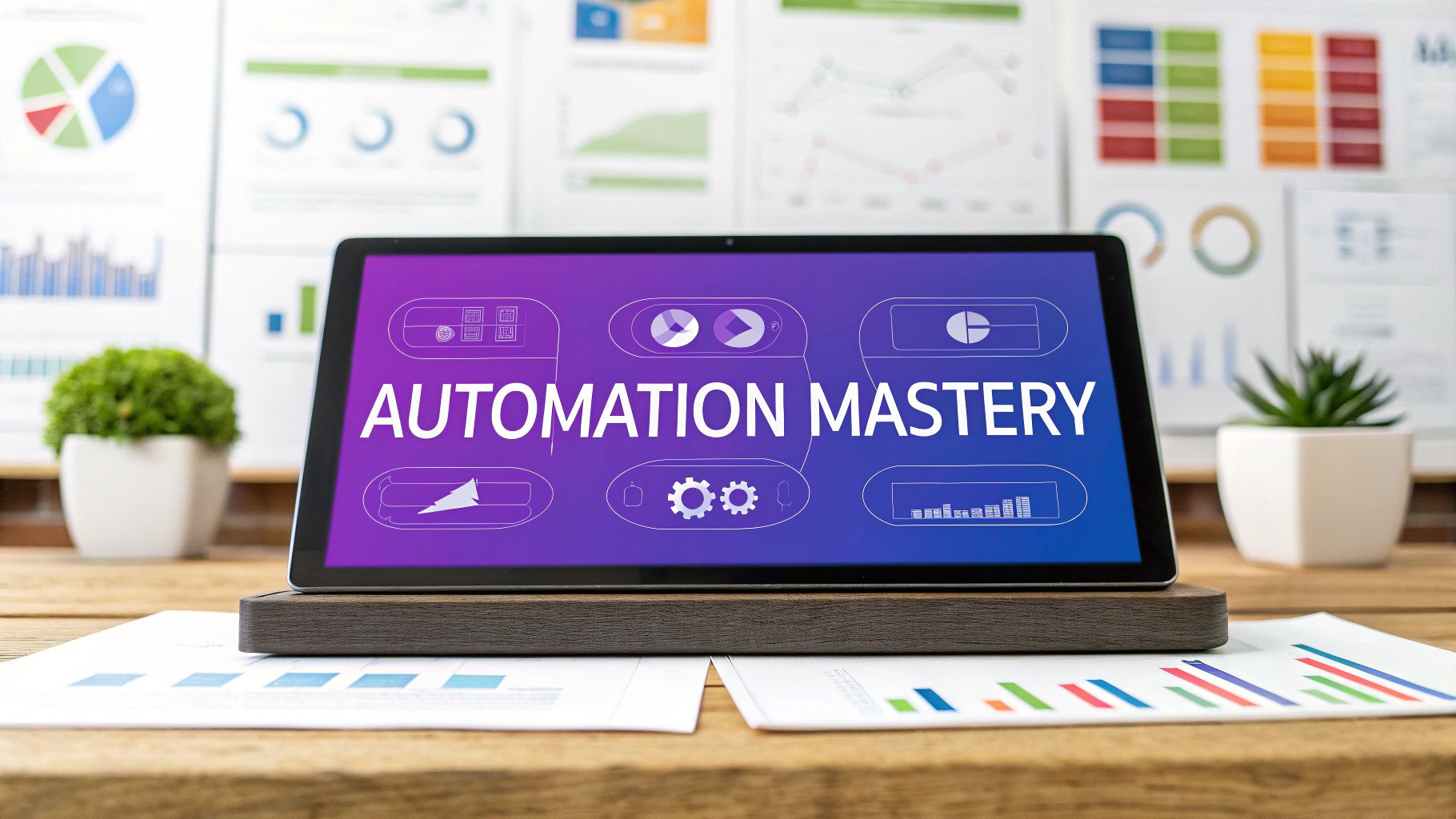What Is Content Optimization? Boost Your Rankings Today
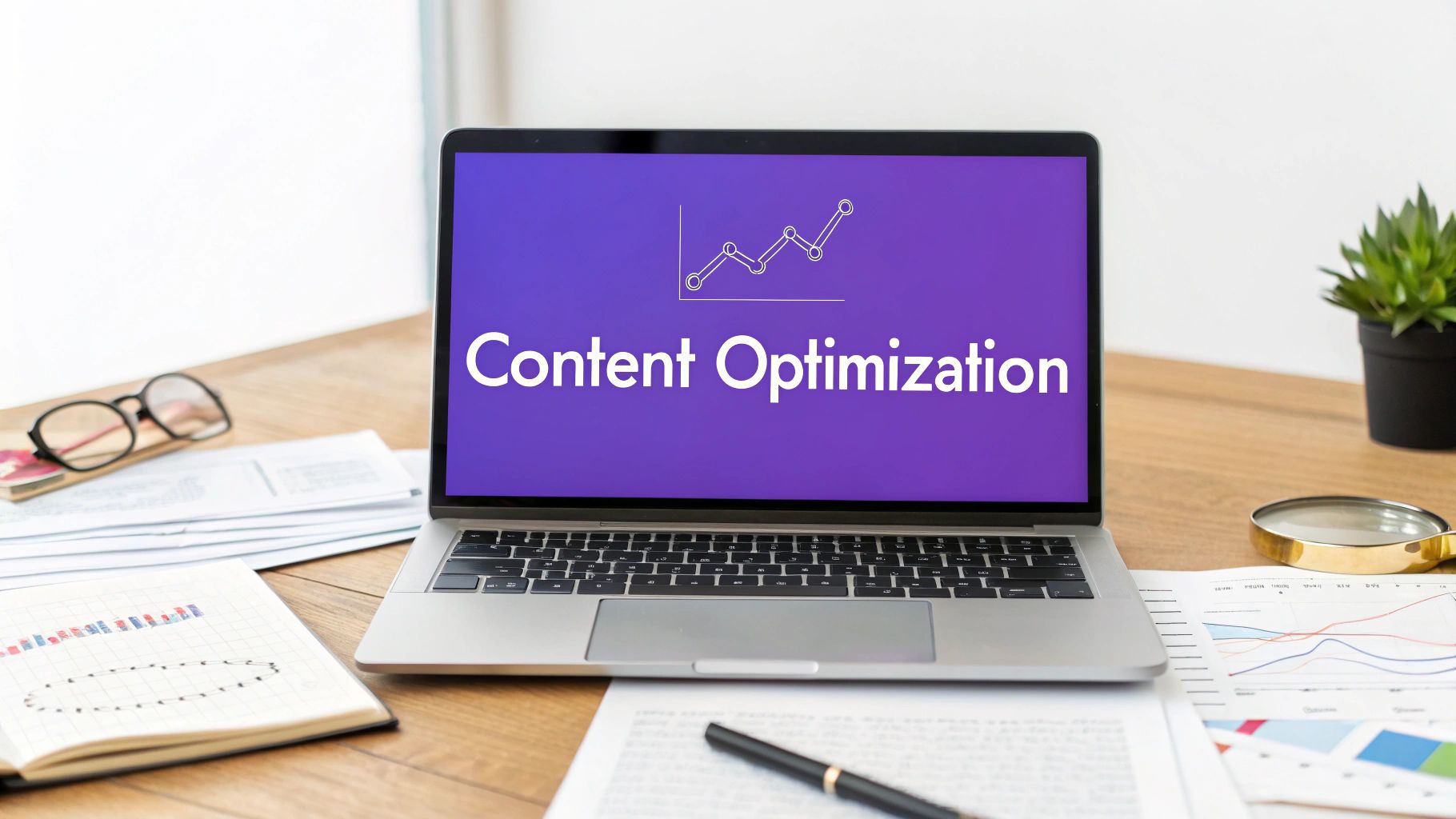
Content optimization is all about taking what you’ve already created and making it better—more visible, more engaging, and more effective. It’s the process of refining your existing content to make sure it hits the mark with both your audience and search engines, long after you first published it.
The Purpose Of Content Optimization
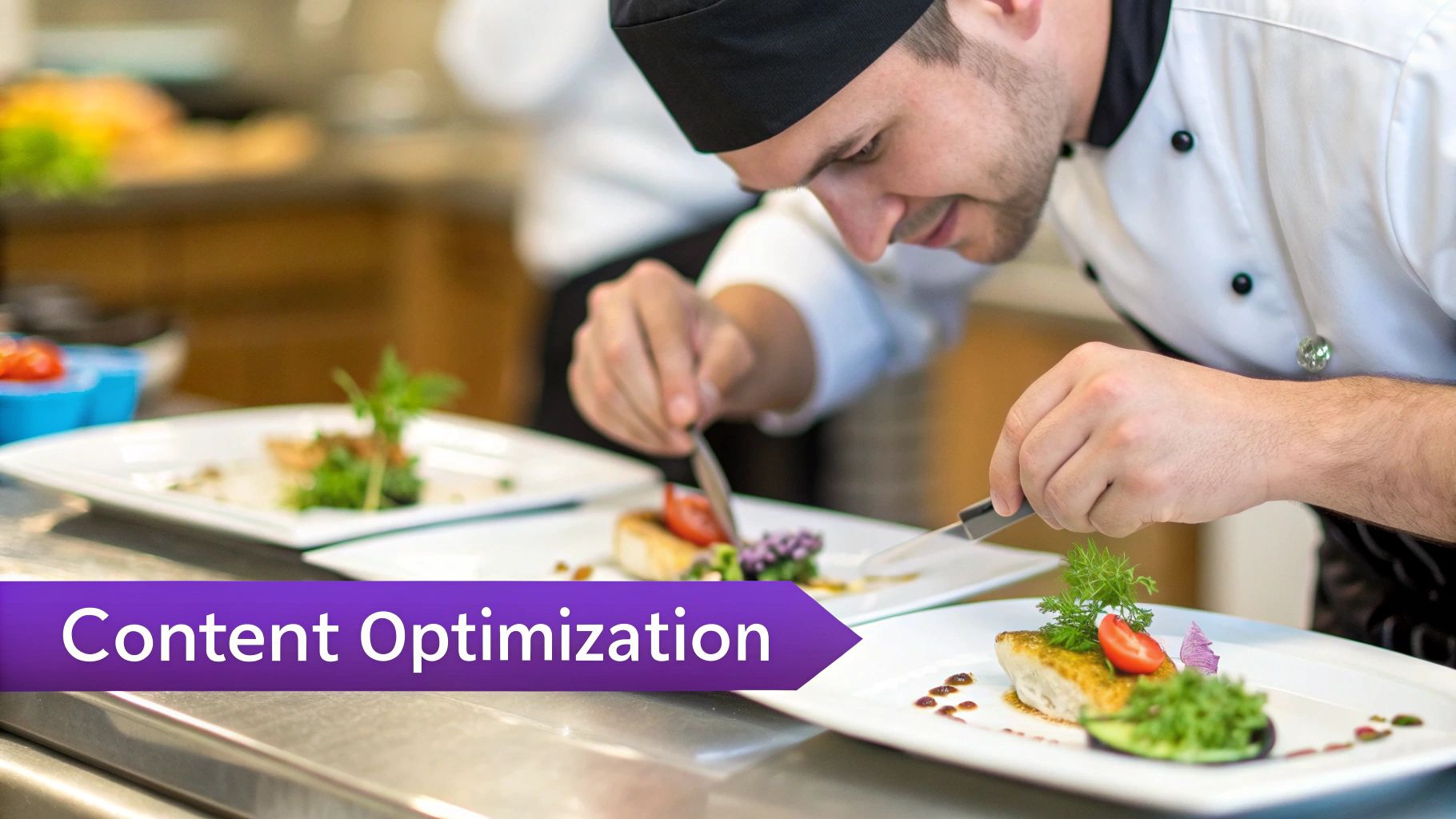
Think of a piece of content not as a finished product, but as a living asset. Content optimization is the ongoing work that keeps this asset valuable and relevant.
It’s like a skilled chef perfecting a signature dish. The core ingredients are already there, but small tweaks to the seasoning, presentation, and technique can transform it from just good to truly unforgettable. This process is about moving past the "publish and pray" mindset and instead systematically improving your articles, landing pages, and other assets to drive real results. For a deeper dive, understanding SEO content optimization is a great place to start.
Why It Is More Than Just Keywords
Years ago, "optimization" often just meant stuffing a page with keywords. Today, it's a whole different ballgame, driven by smarter search algorithms and higher user expectations.
Modern content optimization is a multi-faceted approach that juggles several key elements at once:
- Search Engine Visibility: Updating your content so it ranks higher for the right keywords and actually answers the questions people are asking.
- User Experience (UX): Making your content a pleasure to read by improving its structure, adding helpful visuals, and ensuring it’s easy to navigate. This keeps people on your page longer.
- Conversion Rates: Sharpening your calls-to-action (CTAs), clarifying your message, and gently guiding readers toward a specific goal, like signing up for a demo.
The goal is to create a virtuous cycle: better user engagement signals quality to search engines, which then boosts your rankings and brings in even more traffic.
This shift is a direct response to a massively competitive digital space. The global content marketing market was valued at $413.2 billion in 2022 and is expected to rocket to $2 trillion by 2032. With that much noise, optimization isn’t just a nice-to-have—it’s essential for getting noticed. It's a cornerstone of any solid content marketing strategy.
The Tangible Impact Of Optimization
To see the real-world difference, let's look at the typical results before and after a thorough optimization effort. The changes are often dramatic, turning underperforming content into your best traffic drivers.
The table below gives you a clear picture of the impact you can expect when you start refining your content with purpose.
The Impact of Content Optimization Before And After
| Metric | Before Optimization | After Optimization |
|---|---|---|
| Organic Traffic | Low, stagnant, or declining | 50-200% increase or more |
| Keyword Rankings | Outside top 10 for key terms | Top 3-5 positions for target keywords |
| Click-Through Rate (CTR) | Below average (e.g., 1-2%) | Above average (e.g., 5-10%+) |
| Time on Page | Low (under 1 minute) | High (3+ minutes) |
| Conversion Rate | Less than 1% | 2-5% or higher |
| Bounce Rate | High (over 70%) | Lower (under 50%) |
As you can see, the improvements aren't just marginal. A strategic approach to optimization can breathe new life into your content, delivering significant returns on your initial investment.
The Three Pillars Of Modern Content Optimization

To really get what content optimization is all about, you need to see it as a structure built on three core pillars. If you neglect one, the whole thing gets wobbly. These pillars are Search Engine Optimization (SEO), User Experience (UX), and Conversion Rate Optimization (CRO).
Think of them like a three-legged stool. If one leg is too short—say, you nail the SEO but deliver a clunky user experience—the stool topples over, and your reader is gone. Real success only happens when all three work together.
Search Engine Optimization: The Foundation
SEO is the pillar that gets your content found in the first place. It’s all about sending the right signals to search engines like Google, proving your page is a credible and relevant answer to what someone is looking for. This goes way beyond just stuffing in a few keywords.
Today, SEO is a much bigger game:
- Semantic Relevance: This means covering a topic from all angles, answering related questions, and using the language your audience expects.
- Technical Health: Your site has to be fast, secure, and built in a way that search engine crawlers can easily read and understand.
- Authority Building: This is about earning trust, which often comes from getting backlinks from other reputable sites and proving your expertise over time.
For 35% of B2B marketers, SEO remains a top priority, and it’s easy to see why. Blogs, websites, and SEO still account for 16% of the channels with the highest ROI in 2024. A crucial part of that is finding niche keywords that help you connect with the right audience.
User Experience: The Human Connection
Once someone lands on your page, UX takes over. This pillar is all about how a person feels while they're interacting with your content. Is it a smooth and enjoyable ride, or a confusing, frustrating mess?
A great user experience turns a casual visitor into an engaged reader. It confirms they’ve come to the right place and makes them want to stick around, explore, and actually trust what you have to say.
Key ingredients for a solid UX include:
- Readability: Using short paragraphs, clear headings, and simple language.
- Mobile-Friendliness: Making sure your content looks and works great on any device.
- Page Speed: Loading everything quickly so people don't get impatient and bounce.
These factors directly influence metrics like time on page and bounce rate, which are powerful signals to search engines. For a deeper dive, check out our guide on how to create engaging content.
Conversion Rate Optimization: The Action Driver
The final pillar, CRO, is what turns your readers into customers. It's the art of guiding your audience toward a specific action, whether that’s signing up for a newsletter, downloading a guide, or requesting a demo.
Conversion optimization is all about clarity and persuasion. It involves writing compelling calls-to-action (CTAs), using persuasive language, and creating a flow that makes taking the next step feel like the natural thing to do. Without this pillar, even content that ranks well and delights users won't deliver any real business results. It’s what ensures your content doesn't just inform—it performs.
Building Your Content Optimization Workflow
Knowing the theory behind content optimization is one thing, but actually putting it into practice is a whole different ballgame. The secret isn't a complex, mystical process; it's a systematic, repeatable workflow that separates sporadic improvements from consistent, measurable growth.
Think of it as creating a clear roadmap. Instead of guessing what to improve, you’ll have a data-backed plan to spot opportunities and take decisive action. This is how you focus your time and energy on the content that has the highest potential to make a real impact.
This visual gives a great overview of the core cycle for successful content optimization.
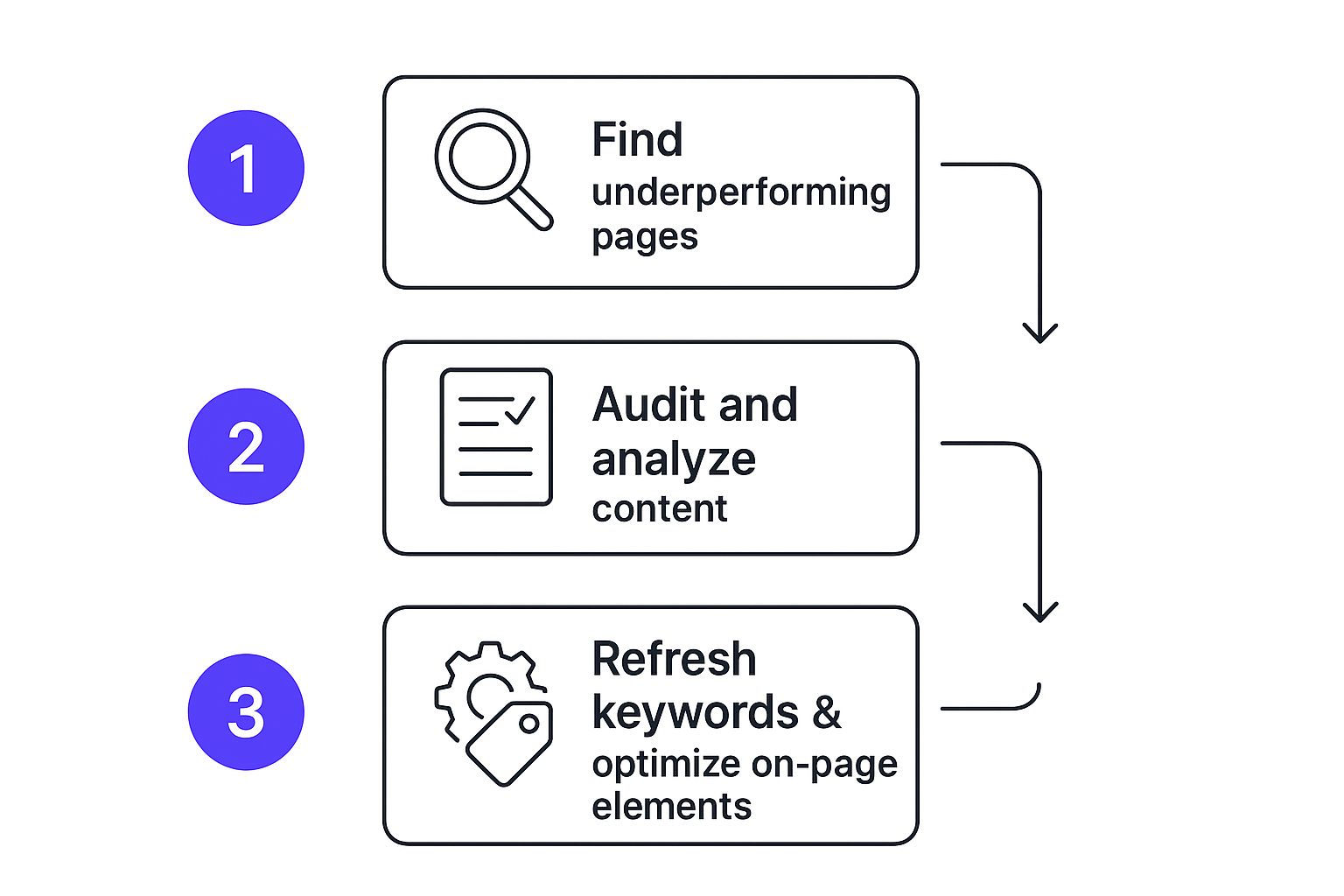
This simple, three-step loop—Find, Audit, and Refresh—is the backbone of any effective content strategy that’s built to last.
Stage 1: Find Underperforming Pages
First things first: you need to become a content detective. Your mission is to pinpoint the pages that just aren't pulling their weight. These are your "low-hanging fruit"—articles with untapped potential that could perform significantly better with a little TLC.
Start by diving into your analytics. Tools like Google Analytics and Google Search Console are your best friends here. You’re looking for pages that fit these profiles:
- High Impressions, Low Clicks: The page is showing up in search results, but nobody’s clicking. This usually means the topic is right, but your title tag or meta description is failing to grab attention.
- Ranking on Page Two or Three: These articles are so close to hitting page one, where over 90% of clicks happen. A small push could be the difference between getting lost in the shuffle and driving serious traffic.
- High Traffic, Low Engagement: People are landing on the page, but they aren't sticking around. This is a classic sign of a mismatch with user intent, poor readability, or content that just isn't deep enough.
Finding these pages gives you a clear, prioritized hit list. This ensures your efforts are aimed where they'll make the biggest splash. A huge part of this is properly measuring digital marketing effectiveness so you know exactly which metrics are screaming "underperformance."
Stage 2: Audit and Analyze Content Gaps
Once you have your target list, it’s time to put on your analyst hat. A thorough audit isn't just a quick skim—it’s a deep dive to diagnose precisely why a piece of content is failing. You need to look at it from two angles: the user's perspective and the search engine's.
During your audit, ask yourself some tough questions:
- Does this content truly, completely answer the user's search query?
- Is the information still accurate? Is it up-to-date?
- How does our page stack up against the top-ranking competitors for the same keyword?
- Is the formatting clean, easy to read, and mobile-friendly?
Using a tool like Ahrefs can be a game-changer here. It lets you analyze competitor content to see what they're doing right and where you have gaps. Maybe they included a helpful video, a detailed FAQ section, or some original data that you missed entirely. This analysis becomes the blueprint for your refresh.
Your audit should result in a specific, actionable to-do list for each article. Instead of a vague goal like "improve this page," you'll have concrete tasks like "add a section on common mistakes" or "update all statistics from 2021 to current."
Stage 3: Refresh Keywords and On-Page Elements
With your audit complete and a clear plan in hand, it's time to execute. This is where you roll up your sleeves and implement the improvements you identified. The goal is to refresh the content so it aligns perfectly with current search intent and what users actually expect to find.
This involves a few key moves:
- Update Keyword Targeting: Search intent shifts over time. Fire up a keyword research tool to see if new, relevant terms have popped up or if the meaning of your primary keyword has evolved.
- Rewrite and Expand Content: This is your chance to add more depth, include fresh examples, and swap out any outdated information. Go through and rewrite weak or unclear sections to make them stronger and more impactful.
- Optimize On-Page Elements: Craft a more compelling title tag and meta description that begs to be clicked. Tweak your headings, add descriptive alt text to your images, and strengthen your internal linking to other relevant pages.
This final step brings the entire workflow full circle. By systematically finding, auditing, and refreshing your content, you create a powerful engine for continuous improvement that fuels sustainable, long-term organic growth.
Essential Tools for Your Optimization Workflow
Having the right tools can make or break your content optimization workflow. They help you move from guesswork to data-driven decisions at every stage. Here’s a breakdown of some essential tools to build your stack.
| Workflow Stage | Recommended Tools | Primary Use Case |
|---|---|---|
| Find | Google Analytics, Google Search Console, Ahrefs | Identify underperforming pages, track impressions vs. clicks, and find keyword opportunities. |
| Audit | Ahrefs, SEMrush, Clearscope | Analyze competitor content, identify content gaps, and check for on-page SEO issues. |
| Refresh | SurferSEO, Frase.io, Grammarly | Optimize content against top competitors, improve readability, and refine keyword usage. |
Building a toolkit with a few solid options for each stage will streamline your process and make your optimization efforts far more effective.
Using AI For Smarter Content Optimization

Artificial intelligence isn't some far-off concept anymore; it's a practical and powerful partner in the world of content optimization. Don't think of AI as a replacement for your expertise. Instead, picture it as a super-smart assistant, churning through massive amounts of data to help you make better decisions, faster.
This tech cuts right through the marketing noise, uncovering hidden opportunities that even a seasoned pro might miss. AI tools can analyze search trends, pinpoint valuable keyword clusters, and even guess how well your content will perform before you even hit publish. This flips your entire strategy from reactive to proactive.
How AI Enhances The Optimization Process
AI streamlines and sharpens nearly every step of the content workflow. It takes those complex, time-sucking tasks and turns them into simple, data-backed actions.
Here are a few ways AI is already changing the game:
- Generating Content Briefs: AI can digest the top-ranking articles for a target keyword and spit out a comprehensive brief. It will tell you the key topics to cover, common questions people ask, and even a recommended word count.
- Optimizing Headlines: Forget guessing games. AI tools can generate dozens of headline ideas and score them based on their likely click-through rate (CTR), helping you pick a real attention-grabber.
- Ensuring Readability: AI can scan your writing for clarity, tone, and complexity. It offers smart suggestions to make your content easier to read and more engaging for your specific audience.
With these tasks handled, you can get back to focusing on the big picture—strategy and creativity—while the AI does the heavy lifting on the data side. Tons of creators are already using the best AI copywriting tools to dial in their messaging and work more efficiently.
The Measurable Impact Of AI In Marketing
The numbers don't lie. Bringing AI into the mix has completely changed the ROI game for digital campaigns. The global AI marketing market is expected to rocket past $40 billion by 2025. More telling, 68% of executives are already seeing a positive return on their AI investments.
This proves that AI-driven optimization isn't just hype; it delivers real, measurable results. In fact, 51% of marketers now use AI to optimize their content, while 50% use it for content creation, showing its power on both sides of the coin.
By automating the tedious research and giving you predictive insights, AI tools empower you to create content that not only ranks higher but truly connects with your audience on a deeper level.
At the end of the day, using AI for content optimization isn't about letting a machine take the wheel. It's about augmenting your own skills with powerful data analysis to get better results, faster than you ever could before. It’s how you keep your content competitive and effective.
Real Examples Of Content Optimization Success
Theory and workflows are great, but let's be honest—seeing real results is what makes it all click. These optimization strategies aren't just abstract ideas; they drive real, measurable growth for businesses.
Let's break down a couple of clear examples that show exactly how this works in practice.
B2B Tech Company Triples Organic Traffic
Imagine a B2B software company with a blog post on "remote team productivity." It was written two years ago and did well for a while, but now it’s buried on the third page of Google, bringing in next to nothing.
- Problem: The content was stale. It was packed with 2021 statistics, completely missed new industry trends (like AI tools), and just didn't have the expert depth competitors were offering.
- Solution: They decided to give it a complete refresh. This meant updating every statistic, adding a whole new section on AI productivity tools, and embedding quotes from three industry experts to boost authority. They also tweaked the title and headings to make them more clickable.
- Result: Within just 90 days, the post shot up from page three to the #2 position for its main keyword. Organic traffic to that one article jumped by over 210%, and it quickly became one of their top three lead-generating posts for the quarter.
This is a perfect example of a core principle: your existing content is a goldmine. Instead of letting it gather dust, a strategic refresh can turn a forgotten article into a powerful traffic engine.
E-commerce Brand Boosts Category Page Sales
An online retailer selling eco-friendly home goods had a problem. Their "Sustainable Kitchen Products" category page was getting visitors, but the bounce rate was sky-high. People landed on the page and left without clicking on a single product. Ouch.
- Problem: The page was just a boring grid of products. It offered no context, no compelling copy, and none of the trust signals needed to convince someone to buy.
- Solution: The team got to work. They added a short, engaging intro paragraph explaining the benefits of their sustainable products. They also dropped in a customer testimonial section and added filters so shoppers could sort by material or brand. Finally, they added small descriptive blurbs under each product line to give a little more flavor.
- Result: The page’s bounce rate dropped by 40%, and the conversion rate from that page increased by 18%. This wasn't a massive overhaul, but these simple optimizations directly translated into a serious lift in revenue. These tactics are also great examples of how you can apply smart content repurposing strategies to existing page layouts.
Common Questions About Content Optimization
Diving into content optimization always brings up a few questions. Getting straight answers can be the difference between feeling lost and moving forward with confidence. Let's clear up some of the most common things marketers ask.
One of the first questions is always about timing: how often should you optimize your content? The answer isn’t about a strict schedule, but about being strategic. A good rule of thumb is to revisit your key content every quarter or semi-annually. For your most important pages, you might need to check in more often, especially if you see rankings or traffic start to slip.
Finding The Balance Between SEO And Authenticity
A huge concern for many is how to write for search engines without sounding like a robot. It’s a classic tug-of-war: do you create a keyword-stuffed article that ranks, or a creative piece that no one ever finds?
Here’s the secret: modern SEO is all about the reader. Search engines are designed to reward content that is genuinely helpful, clear, and engaging.
Think of SEO guidelines not as rigid rules, but as a framework for clarity. When you use keywords naturally, structure your content with logical headings, and directly answer the questions people are asking, you’re serving your audience first—and the algorithms second.
This means you never have to sacrifice your brand’s personality. In fact, a strong, authentic voice is a massive advantage that builds trust and keeps people engaged—both are huge green flags for search engines. The goal is to weave SEO practices in so smoothly that they actually make your message stronger, not warp it.
New Content Creation Versus Optimization
Another common point of confusion is whether to focus on creating brand-new content or optimizing what you already have. While they're related, they play very different roles in a strong content strategy.
- Content Creation: This is all about expanding your footprint. You're targeting new keywords, exploring fresh topics, and filling gaps in your content library to attract new audience segments. Every new post is a new lottery ticket for ranking.
- Content Optimization: This is about getting more juice from your existing assets. You're taking content that already has some traffic and authority and making it even better. This often delivers results much faster because you're improving something Google already knows and trusts.
A smart strategy uses both. Optimize your past work to squeeze more value out of it, while creating new content to blaze a trail for future growth.
Common Mistakes To Avoid
Finally, knowing what not to do is just as important as knowing what to do. Steer clear of these common slip-ups to make sure your optimization efforts actually pay off.
- Keyword Stuffing: Jamming keywords into your text where they don't belong is a surefire way to annoy readers and get penalized by search engines. It's an old trick that no longer works.
- Ignoring User Intent: If you only focus on a keyword without understanding why someone is searching for it, your content will miss the mark completely.
- Forgetting Mobile: A massive chunk of your audience is reading on their phones. If your content is a pain to read on a small screen, you'll lose them in seconds.
- Neglecting Internal Links: Failing to link to other relevant articles on your site is a huge missed opportunity. It's one of the easiest ways to boost your authority and guide visitors deeper into your world.
By sidestepping these mistakes, you can be confident your optimization work is genuinely improving your content's performance.
Ready to stop guessing and start growing? With MakerBox, you can create an AI-powered, optimized professional presence in seconds, driving more connections and opportunities. Transform your profiles today.



